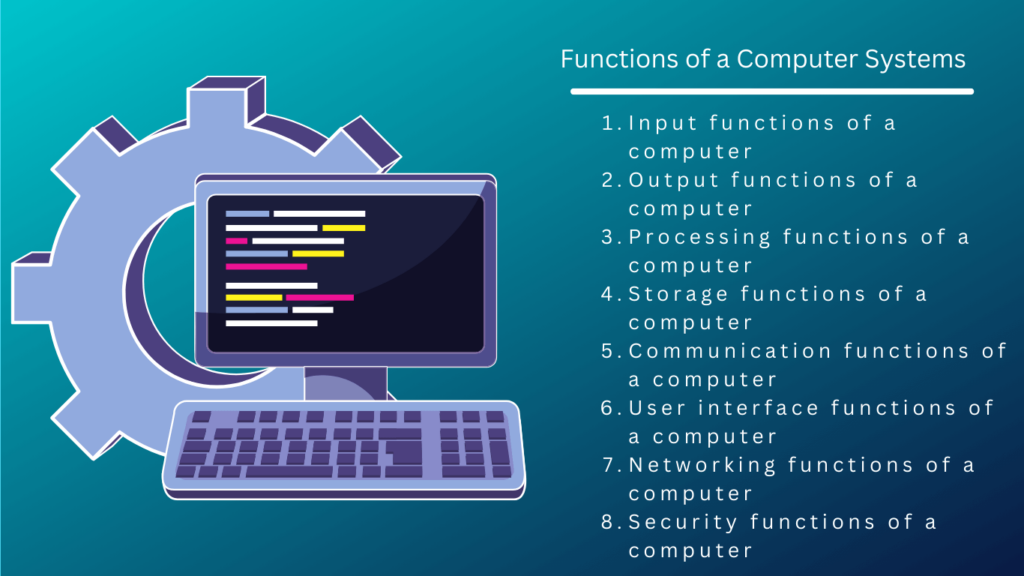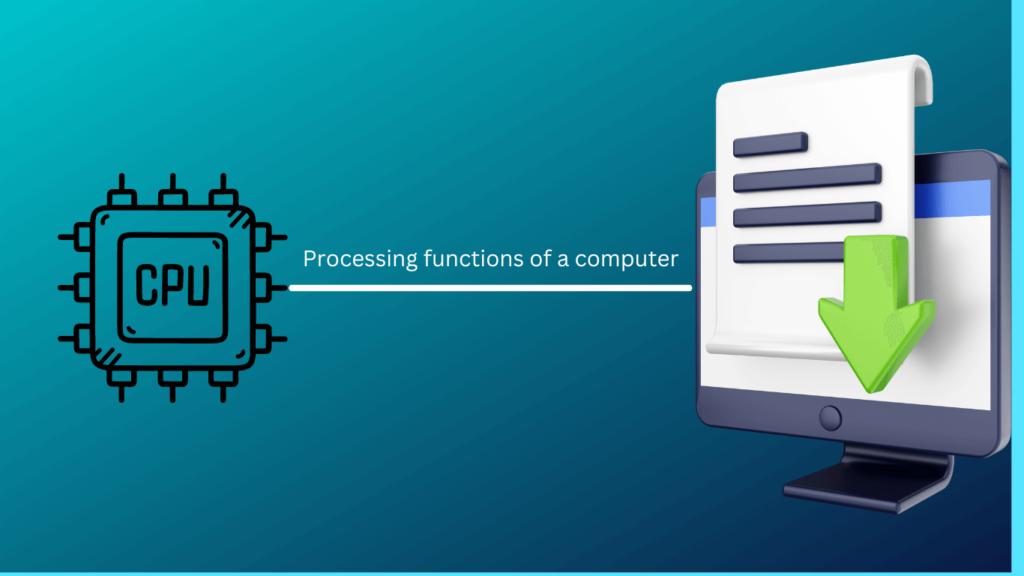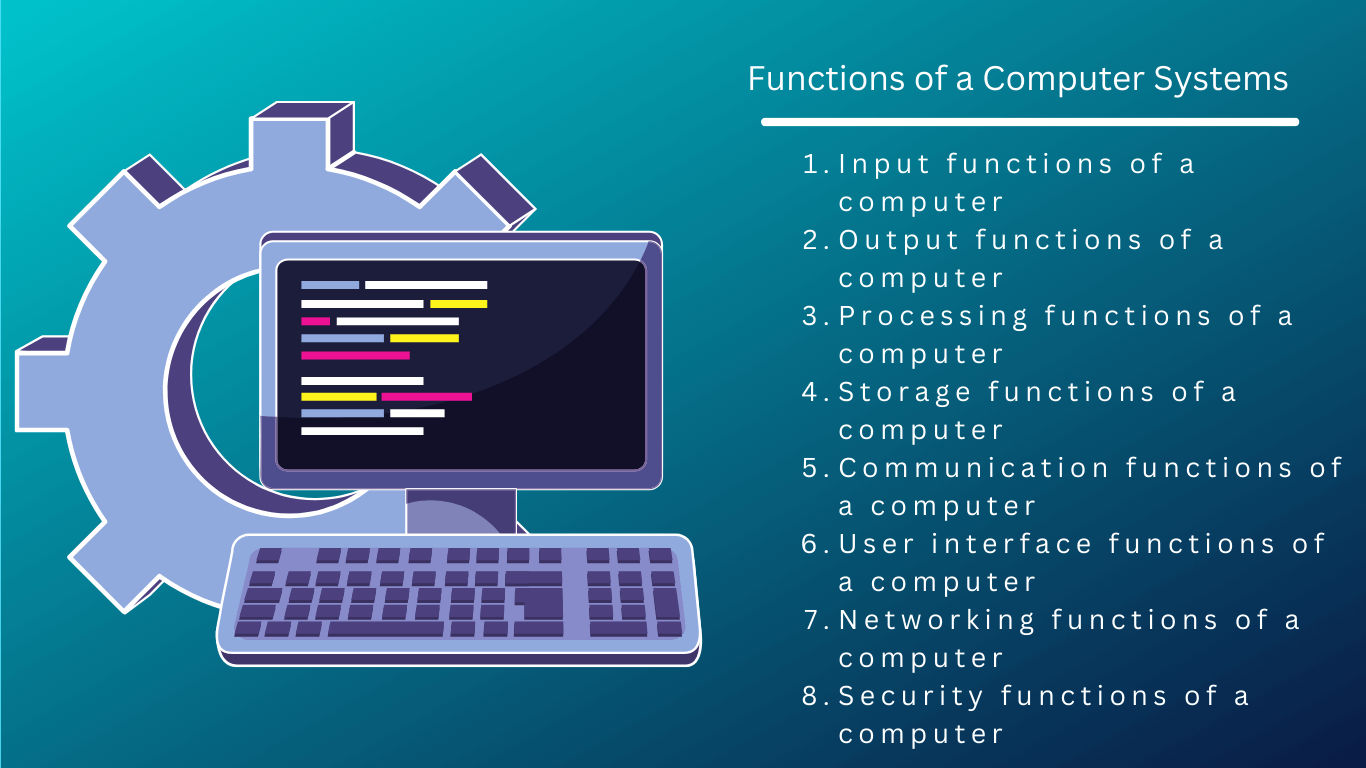Functions of a Computer : Computers have become an integral part of our lives, aiding us in various tasks and activities. But have you ever wondered how a computer actually functions? In this comprehensive guide, we will delve into the essential functions of a computer and explore how they work together to perform complex operations.

Input functions of a computer
The input functions of a computer are responsible for receiving data and instructions from external sources. This can be done through various input devices such as keyboards, mice, scanners, and microphones. These devices allow us to interact with the computer by providing it with the necessary information.
Once the data is received, the computer processes it and converts it into a format that can be understood by the system. This process is known as data input. Whether you’re typing on a keyboard, clicking on a mouse, or scanning a document, the input functions of a computer play a crucial role in capturing and processing the data.
Output functions of a computer
The output functions of a computer are responsible for presenting the processed data to the user in a meaningful way. This can be done through various output devices such as monitors, printers, speakers, and headphones. These devices allow us to perceive and interpret the information provided by the computer.
Whether it’s displaying text and images on a screen, printing documents, or playing audio, the output functions of a computer ensure that the processed data is presented in a format that can be easily understood and utilized by the user. Without these output functions, the data processed by the computer would remain inaccessible and meaningless.
Processing functions of a computer
The processing functions of a computer are responsible for manipulating and transforming data to perform various tasks. This is done through the central processing unit (CPU), which is often referred to as the “brain” of the computer. The CPU executes instructions and performs calculations to process the data received from the input devices.

The processing functions of a computer involve various operations such as arithmetic calculations, logical comparisons, and data transformations. These operations are performed by the CPU using a combination of hardware and software components. The processing functions determine the speed and efficiency of a computer, making it capable of handling complex tasks and computations.
Storage functions of a computer
The storage functions of a computer are responsible for storing and retrieving data for future use. Computers utilize various types of storage devices such as hard disk drives (HDDs), solid-state drives (SSDs), and random-access memory (RAM). These devices allow us to store large amounts of data and access it quickly whenever needed.
The storage functions of a computer can be divided into two categories: primary storage and secondary storage. Primary storage refers to the temporary storage used by the computer to hold data that is currently being processed. On the other hand, secondary storage refers to the long-term storage used to store data even when the computer is turned off.
Communication functions of a computer
The communication functions of a computer enable it to exchange information with other computers and devices. This is done through various communication channels such as wired and wireless networks. Computers can connect to the internet, share data, and communicate with each other using protocols and networking technologies.
The communication functions of a computer play a vital role in enabling us to access and share information globally. Whether it’s sending emails, browsing the web, or video conferencing, computers rely on their communication functions to establish and maintain connections with other devices and networks.
User interface functions of a computer
The user interface functions of a computer are responsible for facilitating interaction between the user and the computer system. This includes the design and layout of graphical user interfaces (GUIs), command-line interfaces (CLIs), and touch-based interfaces. The user interface functions determine how users interact with the computer and access its features and functions.
User interface functions aim to provide a user-friendly and intuitive experience, enabling users to navigate through the computer system, access applications, and perform tasks efficiently. Without these functions, computers would be difficult to operate and navigate, hindering productivity and usability.
Networking functions of a computer
The networking functions of a computer enable it to connect and communicate with other computers and devices within a network. This can be done through wired or wireless connections, allowing for the sharing of resources, files, and information. Networking functions are essential for businesses, organizations, and individuals to collaborate and share data efficiently.
Computers utilize networking protocols and technologies to establish connections, transfer data, and manage network resources. Whether it’s a local area network (LAN), wide area network (WAN), or the internet itself, networking functions play a crucial role in enabling computers to connect and communicate on a global scale.
Security functions of a computer
The security functions of a computer are responsible for protecting the system and its data from unauthorized access, threats, and vulnerabilities. This includes the implementation of security measures such as encryption, firewalls, antivirus software, and user authentication. Security functions help ensure the confidentiality, integrity, and availability of data and resources.
In an increasingly interconnected world, computer security has become a top priority. With the rise of cybercrime and data breaches, computers need robust security functions to safeguard sensitive information and prevent unauthorized access. Without these functions, computers would be vulnerable to malicious attacks and compromise.
Conclusion :
In this comprehensive guide, we have explored the essential functions of a computer and how they work together to enable us to perform various tasks and activities. From input and output functions to processing, storage, communication, user interface, networking, and security functions, each component plays a crucial role in the overall functioning of a computer.
Understanding these functions is essential for users, professionals, and enthusiasts alike, as it allows us to make the most out of our computers and utilize their capabilities to their fullest potential. By appreciating the complexity and interdependence of these functions, we can better navigate the digital landscape and harness the power of computers for personal and professional use.

